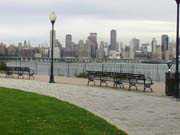West New York and 11 other riverfront cities joined State Environmental Protection Commissioner Bob Shinn and Hudson County Executive Robert Janiszewski in signing an agreement two weeks ago that forms a partnership to forward the completion the Hudson River Walkway. The proposed waterfront walkway, which is being built largely by private developers, will ultimately extend from Bayonne to the George Washington Bridge. The Performance Partnership Agreement will allow local officials to solicit public input and discuss plans for completion of the project.
The construction of the proposed 30-foot-wide, 18 mile long public walkway is now finished on more than 11 miles of the Hudson River. When all 18 miles are complete, the public will be able to walk or bike along the Jersey side of the river. Developers building on private waterfront land are required, by state law, to contribute to the walkway.
“Completing the walkway will assure public access to the Hudson waterfront,” said Commissioner Shinn at a press conference in Hudson County two weeks ago. “[The walkway] will provide pedestrians, joggers, cyclists and anglers with and invigorating and unparalleled space to enjoy the outdoors.”
The walkway will run from the Bayonne Bridge to the George Washington Bridge, linking Liberty State Park with the Palisades Interstate Park facilities. It will connect nine municipalities, including Jersey City, Hoboken, West New York, Weehawken, North Bergen, and Guttenburg.
The concept was first proposed by the Regional Plan Association in 1966. The Department of Environmental Protection adopted regulations in 1980 requiring owners seeking to develop the waterfront to construct and maintain the walkway and provide public access. In 1988, the Hudson River Waterfront Conservancy was created to over see the walkway’s future.
Opposition thwarted
The path to a complete walkway has seen its share of controversy. While construction is more than halfway finished, some developers have not completed their sections of the walkway due to financial constraints or an unwillingness to provide public structures. Some do not like the way the state has gone about requiring them to build. Two builders’ associations sued the state in federal court, claiming that the walkway is an unlawful taking of property without compensation.
In an August 1999 victory for the state Department of Environmental Protection and a consortium of conservation groups, Federal District Judge Garrett E. Brown Jr. ruled that the public has a “public trust” right of access to the Hudson River. Judge Brown found that nearly 90 percent of the land on which the walkway is constructed was at one time part of the Hudson River. Therefore, the land is held by the state in trust for the benefit of the public.
What the partnership means
The 1999 decision paved the way for the new Sept. 15 agreement between the county and the municipalities. The agreement focuses initially on the walkway but will also include provisions for addressing broad environmental issues related to combined sewer overflows and other sources of water. The partnership is expected to produce a comprehensive plan for the construction, completion and maintenance of the walkway, with feedback from the public and other stakeholders. The plan will specify activities to achieve the stated goals and establish deadlines for the completion of each task. A preliminary list of tasks include inventorying all properties along the waterfront, preparing estimates for construction, maintenance and operation of the walkway, identifying potential funding sources, soliciting public opinion regarding design and amenities, and examining long term issues such as maintenance and public safety.
“Today we are one step closer to bringing a Hudson River Walkway to our residents,” said Hudson County Executive Robert Janiszewski. “This project, which will further improve Hudson County’s landscape, has been at the top of our wish list for years and through this partnership with commissioner Shinn and the Hudson County mayors, our time has come. I look forward to bringing this world-class asset to our communities.”
Signing the agreement with Shinn and Janiszewski were West New York Mayor Albio Sires, Bayonne Mayor Joseph V. Doria, East Newark Mayor Joseph Smith, Guttenburg Mayor Robert Sabello, Harrison Mayor Raymond McDonough, Hoboken Mayor Anthony Russo, Jersey City Mayor Bret Schundler, Kearny Mayor Alberto Santos, North Bergen Mayor Nicholas Sacco, Secaucus Mayor Dennis Elwell, Union City Mayor Raul Garcia, and Weehawken Mayor Richard Turner.
